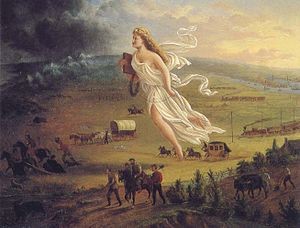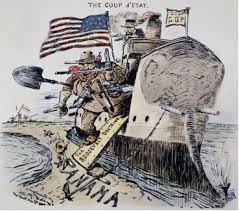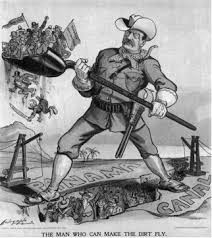Popular culture has been an invaluable source for historical research.Art, film and literature capture a slice of the past that can be impossible to feel with a written document. Scott Fitzgerald’s The Great Gatsby (1925) encapsulates prohibition era America. While Charles’s Dickens’ Oliver Twist (1838) drew attention to the rampant poverty in industrial England.
It’s not just works created during the time that are valuable. Works of popular culture created after the period tell us how people remember and interpret the past. WWII films such as Saving Private Ryan & Letters from Iwo Jima tell us how society today remembers WWII.
Works of popular culture also create a window to history on a more tangible level. We as an audience can get a sense of 1940’s San Francisco by watching the Noir film The Maltese Falcon (1941) or occupied Manchuria in The Human Condition (1951). Bioshock Infinite belongs to this latter category, what’s great about popular culture is that it gives us a feel for the era as well as providing an example of how we remember and react to the past.
Part 1 will examine how Irrational Games used the fictional city of Columbia to present the attitudes and fears of a post-civil war America, while Part 2 will go along slightly different route asking whether particular video games can be considered forms of narrative art.
A view of the floating city of Columbia
Where is Columbia and who is Zachary Hale Comstock?
Despite being fictional, the floating city of Columbia captures the Zeitgeist of an America emerging from the carnage of the Civil War and then going on to become a world’s hegemonic superpower. Fictional settings can provide a brilliant method to showcase the attitudes of the past. In the city of Columbia the racism, Victorian work ethics and patriotism are all exaggerated versions of the real Post Civil-War USA (1865-). The following sections will look at events in real United States history and their representation within the universe of Bioshock Infinite.
 The Cult of Father Comstock in Columbia. Comstock believes he is continuing the ‘true values’ of American society that have been lost since the days of the founding fathers.
The Cult of Father Comstock in Columbia. Comstock believes he is continuing the ‘true values’ of American society that have been lost since the days of the founding fathers.
Manifest Destiny
The floating city of Columbia is founded by Zachary Hale Comstock. Comstock’s a self-made man, a born again Christian and war hero at the Battle of Wounded Knee (1890). Comstock uses his influence and oratory skills to lobby congress for funds to build a ‘New Eden’ with the latest technology in the skies of America.
Comstock’s social position fits into the ideas of Manifest Destiny which were widespread throughout America after the Civil War. Manifest Destiny was a belief that by divine providence Americans were destined to push civilization westwards to the end of the North American continent.
 American Progress 1872 – This painting by John Gast captures the spirit of Manifest Destiny. The women is Columbia, a personification of the United States – as she and the pilgrims move westwards technology (trains and telegraphs) and light (symbolizing Civilization and Christianity) are extended across the continent.
American Progress 1872 – This painting by John Gast captures the spirit of Manifest Destiny. The women is Columbia, a personification of the United States – as she and the pilgrims move westwards technology (trains and telegraphs) and light (symbolizing Civilization and Christianity) are extended across the continent.
Comstock’s destiny is tied to the era of Manifest Destiny – a time when the American dream could be fulfilled and any man can make something of himself. But this is not the only reason Comstock’s background tells us much about real post-civil war USA. Comstock’s role in the ‘battle of Wounded Knee’ (now the Massacre at Wounded Knee) also captures the racism of the time.
The massacre at Wounded Knee resulted from long held European prejudices against the Native Americans alongside increasing tension as European continued to take over the continent.
The seizure of native lands, poverty and disease had created unrest amongst the Lakota Indians. From this atmosphere of turmoil came a prophet in the form of Wovoka. Wovoka told the Lakota that Jesus Christ had returned to earth as a Native American and if a Ghost Dance was performed the buffalo herds would return and the Europeans would be forever raptured from the land. The suspicion and tension aroused by such a large dance eventually resulted in the then called ‘Battle of Wounded Knee’. Chief Oglala Lakota later remembered how the ‘battle’ took place.
“A mother was shot down with her infant; the child not knowing that its mother was dead was still nursing … The women as they were fleeing with their babies were killed together, shot right through … and after most all of them had been killed a cry was made that all those who were not killed or wounded should come forth and they would be safe. Little boys … came out of their places of refuge, and as soon as they came in sight a number of soldiers surrounded them and butchered them there.”
 Native American bodies after the massacre
Native American bodies after the massacre
Now Comstock receives fame for his actions at Wounded Knee, and this is generally the public reaction of the time. Medals of Honor were given out to fighting soldiers, while L. Frank Braum captured popular sentiments writing in a local paper:
‘The Pioneer has before declared that our only safety depends upon the total extermination of the Indians. Having wronged them for centuries, we had better, in order to protect our civilization, follow it up by one more wrong and wipe these untamed and untamable creatures from the face of the earth. In this lies future safety for our settlers and the soldiers who are under incompetent commands. Otherwise, we may expect future years to be as full of trouble with the redskins as those have been in the past.’
Comstock’s rise to influence then is not an anomaly within the fictional world of Columbia but a representation of Manifest Destiny ideals held at that time in which Native Americans were little more than an obstacle that had to be overcome.
 The Battle of Wounded Knee as remembered in Columbia’s ‘Hall of Heroes’. The Native Americans are caricatured as savages brutally slaughtering innocent American women.
The Battle of Wounded Knee as remembered in Columbia’s ‘Hall of Heroes’. The Native Americans are caricatured as savages brutally slaughtering innocent American women.
American Exceptionalizm
Now to move away from the founder of Columbia and onto the city itself. Within the narrative of Bioshock Infinite Columbia first makes an appearance at the 1893 World Columbian Exposition. The 1893 World Columbian Exposition was a real event and Columbia in many ways embodies the White City of the exposition. The exposition was created to celebrate 400 since Columbus had first discovered America. The White City was the central piece of the expo – taking its name from both the neo-classical architecture (which symbolized America’s place taking up the ancient world’s values of liberty) and from the extensive use of street lighting. The White City symbolized more than just Chicago’s rebirth from the recent fire, it was also a display to the world of America’s new power and potential for the future.
 The statue of the republic facing the White City
The statue of the republic facing the White City
It’s fitting that Columbia should make an appearance at the 1893 event. Like the White City Columbia represents American exceptionalism. As the White City has neo-classical architecture so too does Columbia. Columbia, like the White City is a technological marvel – instead of street lights Columbia takes to the sky. Columbia like the White City also seeks to present America as an heir to past European greats – the designs tells the world that ‘Liberty’, Christianity, and Technological innovation, while beginning in the Old World are being perfected in the New World.
Colonial Ambitions?
Although America never dabbled in colonialism to the extent of her European counterparts a post-civil war world America did begin to capture territories. The 1898 Spanish-American war resulted in US control of the Philippines. While the Panama Canal was taken by force.
This all began when the Columbian government refused to accept a US for the region. This coincided with the Panama region was considering independence from Columbia. Upon hearing of this convenient news the US sent the USS Nashville to help support the coup under the pretext of Panama autonomy. The end result was not independence for Panama, instead Panama became a US territory through the Hay-Bunau Varilla Trearty of 1903.

 Political Cartoons of the era depicting President Teddy Roosevelt intentions with Panama.
Political Cartoons of the era depicting President Teddy Roosevelt intentions with Panama.
The US protected its overseas ambitions, even to the extent of American lives abroad. The 1900 Boxer Rebellion in China (much like the Ghost Dance) was a reaction to Europeans gaining foreign land. The boxers believed that the missionaries were crippling China and when their revolt began the lives of US missionaries became endangered. The reaction to the boxers resulted in a coalition of British, Russian, American, French, German and Japanese forces launching an attack on the Boxers.
In the universe of Bioshock Infinite Columbia come’s to the American missionary’s aid – Previously unknown to congress it becomes apparent that the floating city is a heavily armed aerial battleship capable of unleashing devastation on the world below. As a result the tension between Washington and Columbia peaks leading to Columbia to secede from the union.
Comstock, now free of Congress has complete control over his ‘Eden in the Sky’. Comstock begins to believe that Columbia represents the true course of American society; a religious utopia free of government intervention (the abolition of slavery, working regulations.
Race and Class
Comstock’s religious utopia reflects strands of thought amongst some of the Anglo-Saxon puritans who settled New England (these were mostly middle class folk from England’s East Anglia). Comstock’s Utopia also addresses a problem many contemporaries dealt with after the civil war, the gradual emancipation of African Americans.
While slaves were technically free after the civil war a past of racial oppression meant the future was limited. Jim Crow laws forced many ex-slaves to continue working on plantations, while racism in both Southern and Northern cities meant that the African American community was forced into Ghettos. The ‘freedom’ gained for blacks post-civil war seems like a drop in the ocean to us today, yet for contemporaries emancipation meant a great deal of change – and for many a threat on the WASP (White Anglo Saxon Protestant) way of life.
In Columbia racial segregation is forced by both the disapproving look of the community as well as the law – interracial marriage becomes a crime against god and the state. In Columbia, much like New York and Boston racial minorities are relegated to manual labor with no opportunities for upward mobility. Among ‘the despised races’ some fare better than others – blacks sit at the bottom of the pyramid being viewed as ‘savages from the Jungle’ while the Irish fared slightly better despite their ‘cunning ways and Catholic faith’.
 A couple being condemned for interracial marriage – note the minstrel cut-outs in the background
A couple being condemned for interracial marriage – note the minstrel cut-outs in the background
A Kintescope dealing with the ‘Irish problem’
Racial discrimination of course leads to a certain type of job, and in Columbia’s Fink Manufacturing we see a parallel of how companies treated their employees in the early 20th century where workers are expected to be fortunate for their job, while working for pennies and around dangerous equipment. While working ideals where lax in America (little safety standards amongst dangerous machines and low wages) things became even worse when America companies set up factories abroad. One prominent example is Fordlandia, a rubber plantation established in Brazil in 1920 by none other than Henry Ford. Free to build his ‘ideal’ working environment employees in Fordlandia where made to attend mandatory social events, follow strict diets set by the company and work a minimum of eight hours a day. Away from federal government interference Fink manufacturing of Columbia has many similarities to Fordlandia.
 The employee village in Fordlandia
The employee village in Fordlandia
Two propaganda posters capture the work ethics:
 A propaganda poster from Columbia’s Fink Industries. The poster is targeted at workers while at the same time showcasing contemporary attitudes towards factory workers.
A propaganda poster from Columbia’s Fink Industries. The poster is targeted at workers while at the same time showcasing contemporary attitudes towards factory workers.
 A poster advising workers to work diligently at their jobs lest immigrants take over from them
A poster advising workers to work diligently at their jobs lest immigrants take over from them
~
Bioshock Infiite’s Columbia contains such a level of detail that there are plenty of other parallels to drawn on; the extreme racism in organisations equivalent to the KKK, rebellions, revolutions and strikes of the underclass, and the evangelist interpretation of the Constitution and United States history. What this article does show is that fictional mediums, even when set in alternate realties can provide a commentary on the past, and Infinite captures Pax-Americana like nothing else.
Further Reading/Sources:
http://www.english.illinois.edu/maps/poets/m_r/momaday/knee.htm
http://www.thehenryford.org/research/rubberplantations.aspx
http://www.pbs.org/wgbh/americanexperience/features/teachers-resources/panama-guide/
